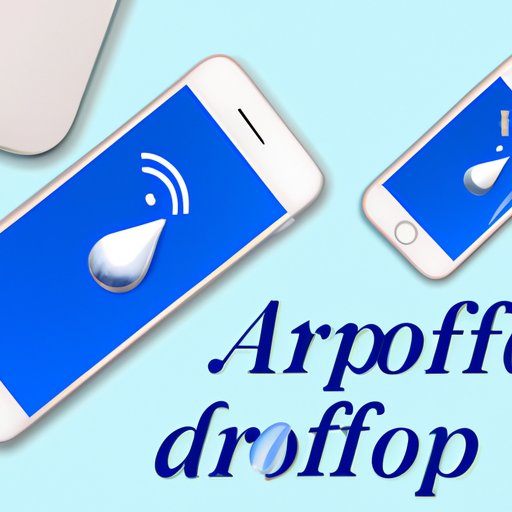
I. Introduction
Transferring files between iPhone and MacBook can be a hassle, especially when using cables. Fortunately, Apple’s Airdrop feature allows users to transfer files wirelessly and conveniently. In this article, we will provide a step-by-step guide on how to Airdrop files from iPhone to MacBook, as well as discuss common errors, advantages and disadvantages, and alternatives to Airdrop.
II. Step-by-Step Guide on How to Airdrop Files from iPhone to MacBook
Before beginning the process, make sure that your iPhone and MacBook are connected to the same Wi-Fi network and Airdrop is enabled on both devices.
To enable Airdrop on your iPhone:
- Swipe up from the bottom of your iPhone screen to access the Control Center.
- Long-press the network settings box in the upper left corner of the Control Center.
- Select “Airdrop” and set it to “Everyone” or “Contacts Only” depending on your preference.
To enable Airdrop on your MacBook:
- Open Finder and click on “AirDrop” in the left sidebar.
- From the settings menu, set “Allow me to be discovered by” to “Everyone” or “Contacts Only” depending on your preference.
To Airdrop files from your iPhone to MacBook:
- Select the file(s) you want to transfer on your iPhone.
- Tap the “Share” icon and select “Airdrop” from the popup menu.
- Find your MacBook in the list of available devices and select it.
- On your MacBook, accept the incoming Airdrop transfer request.
III. Common Errors and How to Fix Them
While Airdrop is generally a reliable method for transferring files, users may encounter common errors such as:
- Airdrop not discovering a device
- Airdrop failing to transfer files
These errors are often caused by issues with Wi-Fi or Bluetooth connectivity. To fix them:
- Make sure that your iPhone and MacBook are connected to the same Wi-Fi network and have Wi-Fi and Bluetooth turned on.
- Turn off Personal Hotspot on your iPhone.
- Restart your iPhone and MacBook.
- Re-enable Airdrop and try transferring the files again.
IV. Advantages and Disadvantages of Using Airdrop
Using Airdrop has several advantages over other file transfer methods:
- It is wireless and does not require cables or a network connection.
- It is quick and easy to use, especially for small files.
- It is secure and does not require any third-party apps.
However, Airdrop also has some disadvantages:
- It is limited to Apple devices.
- It may not be suitable for large files or frequent transfers.
- Occasionally, it may encounter connection errors or be incompatible with older devices.
V. Alternatives to Airdrop
If you encounter Airdrop errors or want to transfer files to non-Apple devices, there are alternative methods:
- iCloud Drive: This feature allows you to store and access files on both iPhone and MacBook using iCloud. It is suitable for files that do not require instant transfer and may be accessed from any device.
- Email: This method works for small files and allows you to send them as attachments via email. However, it may be slow and require larger email storage.
- Third-party apps: There are several file transfer apps such as Dropbox, Google Drive, and WeTransfer that allow you to transfer files between iPhone and MacBook. However, they may require additional fees or storage.
VI. Troubleshooting Airdrop Issues
If you encounter recurring Airdrop issues, here are some tips:
- Ensure that your Wi-Fi and Bluetooth are turned on and connected.
- Move your iPhone and MacBook closer to each other.
- Turn off any firewalls or VPNs that may interfere with the Airdrop connection.
- Check that your iPhone and MacBook are using the latest software updates.
- Reset your network settings by going to “Settings” > “General” > “Reset” > “Reset Network Settings” on your iPhone.
VII. Conclusion
Airdrop is a useful feature that allows you to transfer files between iPhone and MacBook effortlessly. While it may encounter occasional errors, they can often be resolved using simple troubleshooting methods. However, if you prefer alternative file transfer methods, there are several options available. We hope this article has provided you with a comprehensive guide on how to Airdrop files from iPhone to MacBook and helped you choose the perfect file transfer method for your needs.





